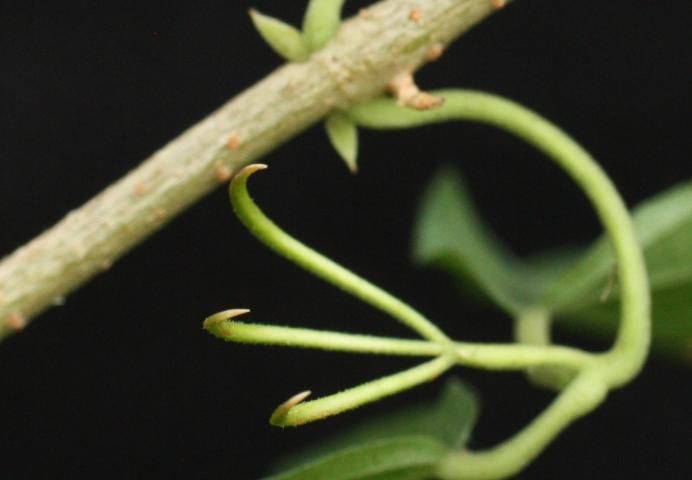At last, spring is here!*
With the warming weather and longer day lengths, plants that have been dormant over the winter start to wake up. New leaves are growing on the trees, flowers are beginning to bloom, and if you have a loved one with allergies, you will have noticed that oak tree pollen is once again filling the air. Unfortunately, along with the lovely spring flowers waking up in our yards, weed species are also beginning to yawn and stretch their tendrils toward the sun.

One of these is the notorious cat’s-claw vine, or Dolichandra unguis-cati, a tenacious invasive from the West Indies and Central and South America that gets its name from the three-pronged “claws” it uses to creep up tree trunks, fences, and walls. Left to itself, cat’s-claw will clamber over and smother everything in your yard trying get to the top of every living thing and every structure it encounters so that it can make its way to the full sunlight it needs to bloom.
If you stood still long enough, it would absolutely climb you, too, but don’t. Standing still is the wrong approach if you spot cat’s-claw in your yard because if you lose interest in it long enough that the vine manages to steal sufficient sun from your trees to bloom, then woe betide your entire neighborhood. Cat’s-claw flowers are lovely, but they send their seeds airborne on spring and summer breezes into everybody’s yards.
*Sort of, anyway. Turns out March 1 is the first day of meteorological spring.
Battling cat’s-claw
To control cat’s-claw in your yard, follow the advice in the EDIS publication Cat’s-Claw Vine, Dolichandra unguis-cati—a Showy but Invasive Plant in Florida. Or, if the infestation is small and if it hasn’t been left alone for too many years, you can try to control the vine by pulling it manually. Grab the stem close to the ground and pull slowly but steadily. It will try to thwart you by breaking, leaving its deceptively wispy roots and tiny tubers** below the surface to grow yet more vines while you’re not looking. Refuse to be dissuaded. Dig a couple of inches down, grasp the stem again, and keep pulling until you unearth the little tuber. Repeat until darkness falls. You can use a garden fork or a trowel to help you dig. Put all plant parts from cat’s-claw in the garbage, not the compost.

Late winter/early spring is a great time to weed because young, tender weeds are easier to pull. With cat’s-claw vine, you must be tenacious and never give up. You may pull every visible plant and come back a month later and see a whole bunch more. It keeps coming back from its evil little underground tubers year after year, and you can’t possibly find all of them in a single weeding session or even a season of steady weeding. But if you keep at it, you’ll see it gradually falter and fall back. Progress! Eventually you will reclaim your trees, fences, and garden structures. What better way to celebrate the springtime?
**So technically they’re not true tubers, which are growths found on plant stems, not on roots. They’re more properly called root swellings. But “tubers” sounds more insidious, so we’re going to go with that.
 4
4
